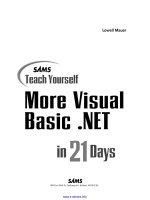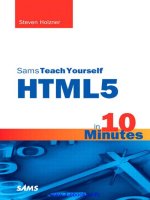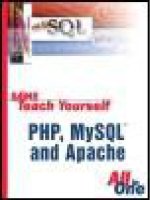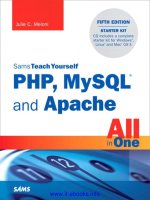Sams Teach Yourself PHP, MySQL and Apache doc
Bạn đang xem bản rút gọn của tài liệu. Xem và tải ngay bản đầy đủ của tài liệu tại đây (8.71 MB, 2,656 trang )
Sams Teach Yourself PHP,
MySQL and Apache All in One
Table of Contents
Copyright
About the Authors
Lead author
Contributing authors
Acknowledgments
We Want to Hear from You!
Reader Services
Introduction
Who Should Read This Book?
How This Book Is Organized
Conventions Used in This Book
Part I: Laying the Groundwork
Chapter 1. Installing and
Configuring MySQL
Current and Future Versions of
MySQL
How to Get MySQL
Installing MySQL on
Linux/Unix
Installing MySQL on Windows
Troubleshooting Your
Installation
Basic Security Guidelines
Introducing the MySQL
Privilege System
Working with User Privileges
Summary
Q&A
Workshop
Chapter 2. Installing and
Configuring Apache
Current and Future Versions of
Apache
Choosing an Installation
Method
Installing Apache on Linux/Unix
Installing Apache on Windows
Apache Configuration File
Structure
Apache Log Files
Apache-Related Commands
Starting Apache for the First
Time
Troubleshooting
Summary
Q&A
Workshop
Chapter 3. Installing and
Configuring PHP
Current and Future Versions of
PHP
Building PHP on Linux/Unix
with Apache
Installing PHP Files on
Windows
php.ini Basics
Testing Your Installation
Getting Installation Help
The Basics of PHP Scripts
Summary
Q&A
Workshop
Part II: PHP Language
Structure
Chapter 4. The Building Blocks
of PHP
Variables
Data Types
Operators and Expressions
Constants
Summary
Q&A
Workshop
Chapter 5. Flow Control
Functions in PHP
Switching Flow
Loops
Code Blocks and Browser
Output
Summary
Q&A
Workshop
Chapter 6. Working with
Functions
What Is a Function?
Calling Functions
Defining a Function
Returning Values from User-
Defined Functions
Variable Scope
Saving State Between Function
Calls with the static Statement
More About Arguments
Testing for the Existence of a
Function
Summary
Q&A
Workshop
Chapter 7. Working with
Arrays and Objects
What Is an Array?
Creating Arrays
Some Array-Related Functions
Creating an Object
Object Inheritance
Summary
Q&A
Workshop
Part III: Getting Involved with
the Code
Chapter 8. Working with
Strings, Dates, and Times
Formatting Strings with PHP
Investigating Strings in PHP
Manipulating Strings with PHP
Using Date and Time Functions
in PHP
Summary
Workshop
Chapter 9. Working with Forms
Creating a Simple Input Form
Accessing Form Input with
User-Defined Arrays
Combining HTML and PHP
Code on a Single Page
Using Hidden Fields to Save
State
Redirecting the User
Sending Mail on Form
Submission
Working with File Uploads
Summary
Workshop
Chapter 10. Working with User
Sessions
Session Function Overview
Starting a Session
Working with Session Variables
Passing Session IDs in the
Query String
Destroying Sessions and
Unsetting Variables
Summary
Q&A
Workshop
Chapter 11. Working with Files
and Directories
Including Files with include()
Testing Files
Creating and Deleting Files
Opening a File for Writing,
Reading, or Appending
Reading from Files
Writing or Appending to a File
Working with Directories
Summary
Q&A
Workshop
Chapter 12. Working with the
Server Environment
Opening Pipes to and from
Processes Using popen()
Running Commands with
exec()
Running Commands with
system() or passthru()
Summary
Q&A
Workshop
Chapter 13. Working with
Images
Understanding the Image-
Creation Process
Necessary Modifications to
PHP
Drawing a New Image
Getting Fancy with Pie Charts
Modifying Existing Images
Summary
Q&A
Workshop
Part IV: PHP and MySQL
Integration
Chapter 14. Learning the
Database Design Process
The Importance of Good
Database Design
Types of Table Relationships
Understanding Normalization
Following the Design Process
Summary
Q&A
Workshop
Chapter 15. Learning Basic
SQL Commands
Learning the MySQL Data
Types
Learning the Table Creation
Syntax
Using the INSERT Command
Using the SELECT Command
Using WHERE in Your Queries
Selecting from Multiple Tables
Using the UPDATE Command
to Modify Records
Using the REPLACE Command
Using the DELETE Command
Frequently Used String
Functions in MySQL
Using Date and Time Functions
in MySQL
Summary
Q&A
Workshop
Chapter 16. Interacting with
MySQL Using PHP
Connecting to MySQL with
PHP
Working with MySQL Data
Summary
Workshop
Part V: Basic Projects
Chapter 17. Managing a Simple
Mailing List
Developing the Subscription
Mechanism
Developing the Mailing
Mechanism
Summary
Q&A
Workshop
Chapter 18. Creating an Online
Address Book
Planning and Creating the
Database Tables
Creating a Menu
Creating the Record Addition
Mechanism
Viewing Records
Creating the Record Deletion
Mechanism
Adding Subentries to a Record
Summary
Workshop
Chapter 19. Creating a Simple
Discussion Forum
Designing the Database Tables
Creating the Input Forms and
Scripts
Displaying the Topic List
Displaying the Posts in a Topic
Adding Posts to a Topic
Summary
Chapter 20. Creating an Online
Storefront
Planning and Creating the
Database Tables
Displaying Categories of Items
Displaying Items
Summary
Workshop
Chapter 21. Creating a
Shopping Cart Mechanism
Planning and Creating the
Database Tables
Integrating the Cart with Your
Storefront
Payment Methods and the
Checkout Sequence
Summary
Workshop
Chapter 22. Creating a Simple
Calendar
Building a Simple Display
Calendar
Creating a Calendar Library
Summary
Q&A
Workshop
Chapter 23. Restricting Access
to Your Applications
Authentication Overview
Apache Authentication Module
Functionality
Using Apache for Access
Control
Combining Apache Access
Methods
Limiting Access Based on
HTTP Methods
Introducing Cookies
Setting a Cookie with PHP
Restricting Access Based on
Cookie Values
Summary
Q&A
Workshop
Chapter 24. Logging and
Monitoring Web Server Activity
Standard Apache Access
Logging
Standard Apache Error Logging
Managing Apache Logs
Logging Custom Information to
a Database
Summary
Q&A
Workshop
Chapter 25. Application
Localization
About Internationalization and
Localization
About Character Sets
Environment Modifications
Creating a Localized Page
Structure
Summary
Q&A
Workshop
Part VI: Administration and
Fine Tuning
Chapter 26. Apache
Performance Tuning and
Virtual Hosting
Scalability Issues
Load Testing with
ApacheBench
Proactive Performance Tuning
Preventing Abuse
Implementing Virtual Hosting
Summary
Q&A









